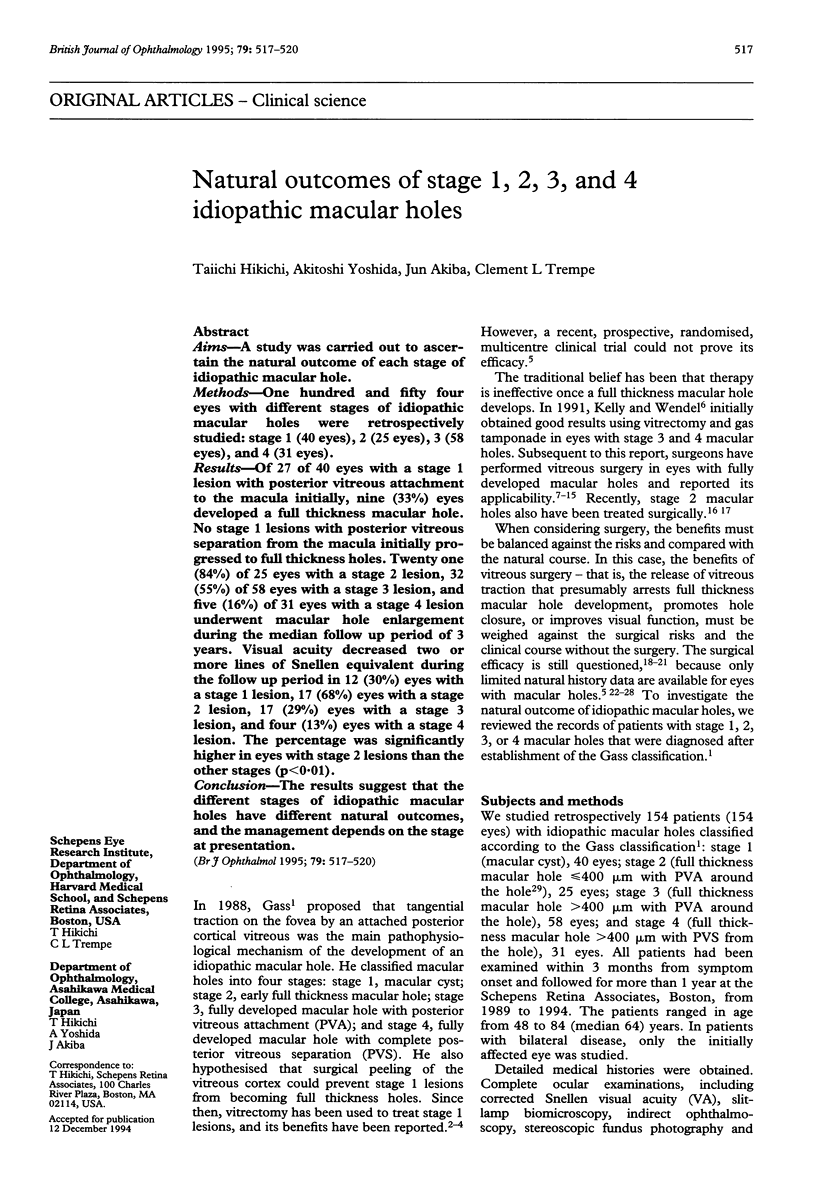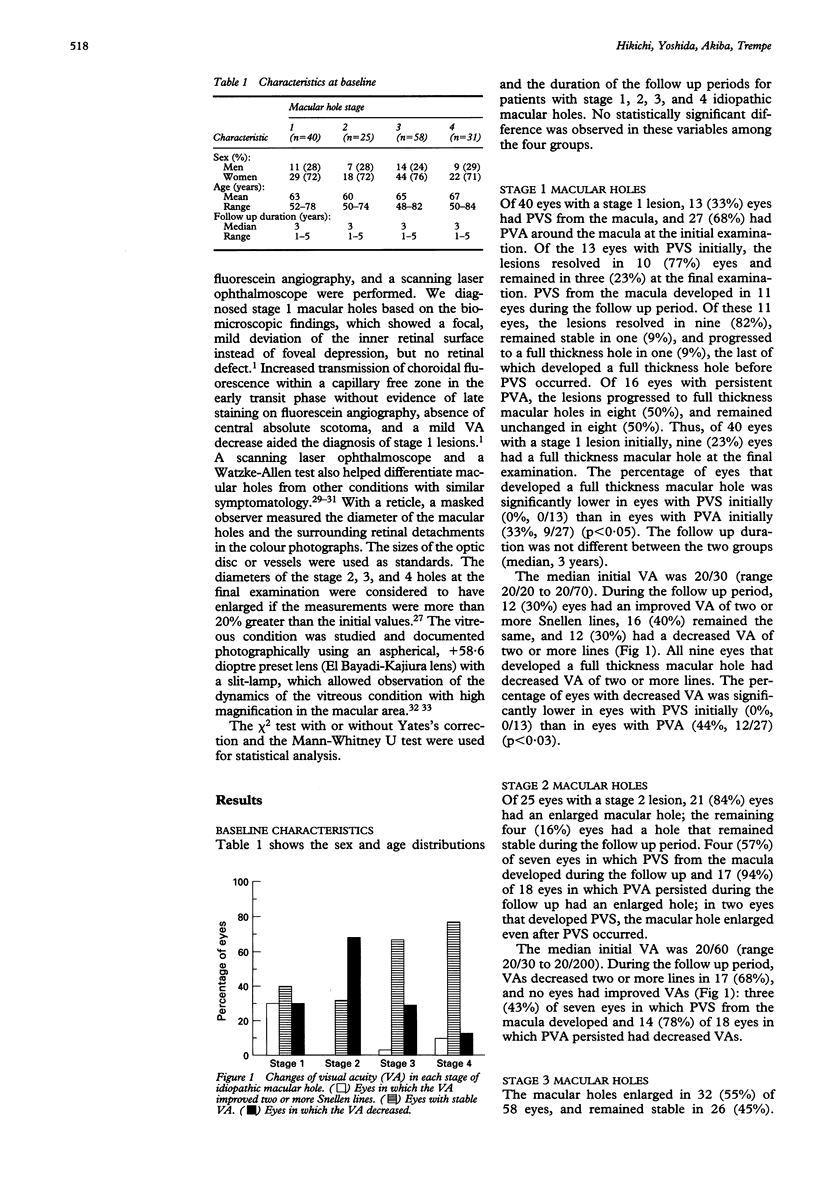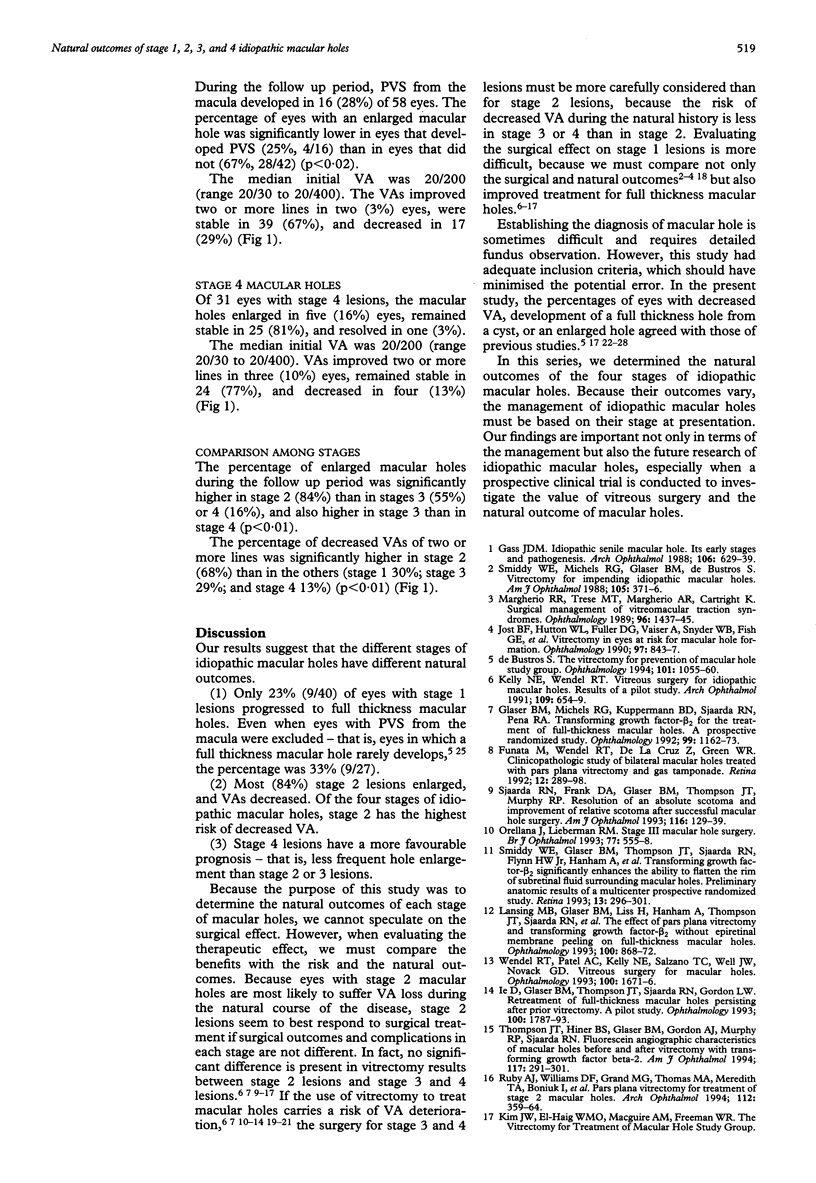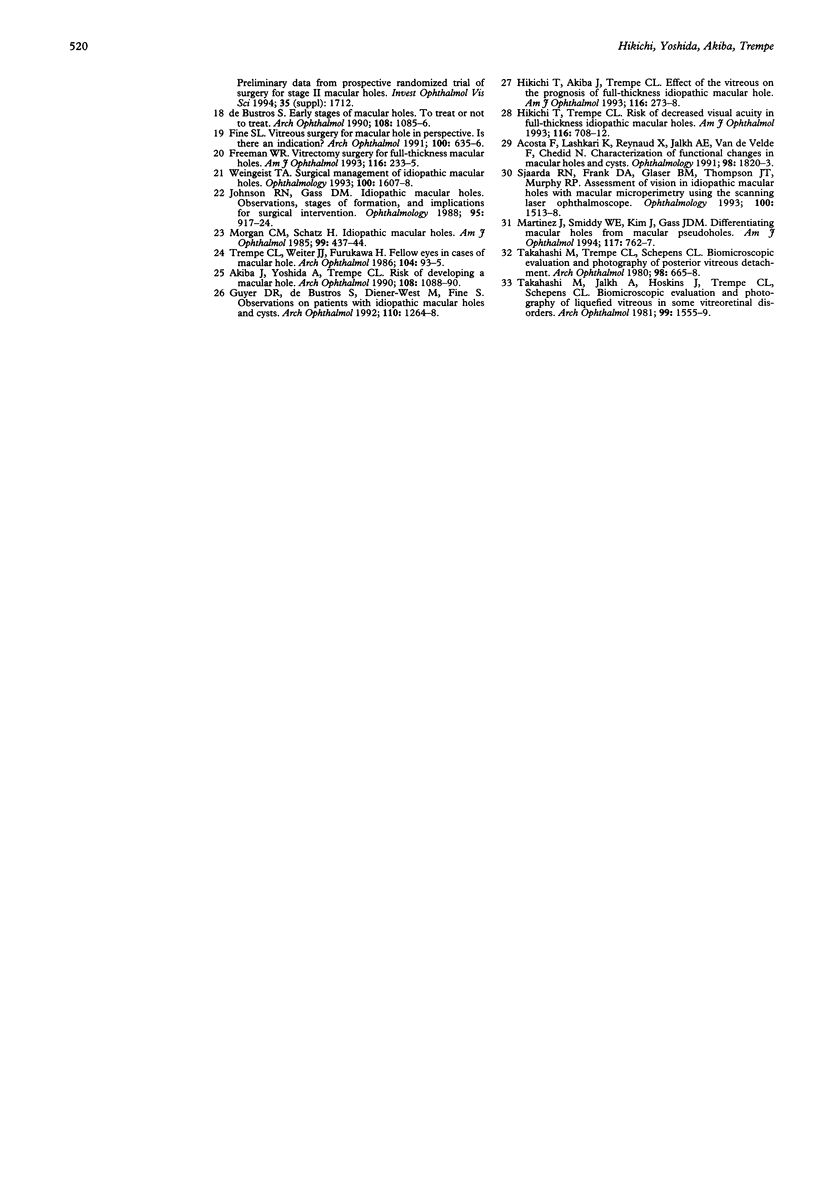Abstract
AIMS--A study was carried out to ascertain the natural outcome of each stage of idiopathic macular hole. METHODS--One hundred and fifty four eyes with different stages of idiopathic macular holes were retrospectively studied: stage 1 (40 eyes), 2 (25 eyes), 3 (58 eyes), and 4 (31 eyes). RESULTS--Of 27 of 40 eyes with a stage 1 lesion with posterior vitreous attachment to the macula initially, nine (33%) eyes developed a full thickness macular hole. No stage 1 lesions with posterior vitreous separation from the macula initially progressed to full thickness holes. Twenty one (84%) of 25 eyes with a stage 2 lesion, 32 (55%) of 58 eyes with a stage 3 lesion, and five (16%) of 31 eyes with a stage 4 lesion underwent macular hole enlargement during the median follow up period of 3 years. Visual acuity decreased two or more lines of Snellen equivalent during the follow up period in 12 (30%) eyes with a stage 1 lesion, 17 (68%) eyes with a stage 2 lesion, 17 (29%) eyes with a stage 3 lesion, and four (13%) eyes with a stage 4 lesion. The percentage was significantly higher in eyes with stage 2 lesions than the other stages (p < 0.01). CONCLUSION--The results suggest that the different stages of idiopathic macular holes have different natural outcomes, and the management depends on the stage at presentation.
Full text
PDF



Selected References
These references are in PubMed. This may not be the complete list of references from this article.
- Acosta F., Lashkari K., Reynaud X., Jalkh A. E., Van de Velde F., Chedid N. Characterization of functional changes in macular holes and cysts. Ophthalmology. 1991 Dec;98(12):1820–1823. doi: 10.1016/s0161-6420(91)32044-x. [DOI] [PubMed] [Google Scholar]
- Akiba J., Yoshida A., Trempe C. L. Risk of developing a macular hole. Arch Ophthalmol. 1990 Aug;108(8):1088–1090. doi: 10.1001/archopht.1990.01070100044031. [DOI] [PubMed] [Google Scholar]
- Fine S. L. Vitreous surgery for macular hole in perspective. Is there an indication? Arch Ophthalmol. 1991 May;109(5):635–636. doi: 10.1001/archopht.1991.01080050049026. [DOI] [PubMed] [Google Scholar]
- Freeman W. R. Vitrectomy surgery for full-thickness macular holes. Am J Ophthalmol. 1993 Aug 15;116(2):233–235. doi: 10.1016/s0002-9394(14)71292-9. [DOI] [PubMed] [Google Scholar]
- Funata M., Wendel R. T., de la Cruz Z., Green W. R. Clinicopathologic study of bilateral macular holes treated with pars plana vitrectomy and gas tamponade. Retina. 1992;12(4):289–298. doi: 10.1097/00006982-199212040-00001. [DOI] [PubMed] [Google Scholar]
- Gass J. D. Idiopathic senile macular hole. Its early stages and pathogenesis. Arch Ophthalmol. 1988 May;106(5):629–639. doi: 10.1001/archopht.1988.01060130683026. [DOI] [PubMed] [Google Scholar]
- Glaser B. M., Michels R. G., Kuppermann B. D., Sjaarda R. N., Pena R. A. Transforming growth factor-beta 2 for the treatment of full-thickness macular holes. A prospective randomized study. Ophthalmology. 1992 Jul;99(7):1162–1173. doi: 10.1016/s0161-6420(92)31837-8. [DOI] [PubMed] [Google Scholar]
- Guyer D. R., de Bustros S., Diener-West M., Fine S. L. Observations on patients with idiopathic macular holes and cysts. Arch Ophthalmol. 1992 Sep;110(9):1264–1268. doi: 10.1001/archopht.1992.01080210082030. [DOI] [PubMed] [Google Scholar]
- Hikichi T., Akiba J., Trempe C. L. Effect of the vitreous on the prognosis of full-thickness idiopathic macular hole. Am J Ophthalmol. 1993 Sep 15;116(3):273–278. doi: 10.1016/s0002-9394(14)71343-1. [DOI] [PubMed] [Google Scholar]
- Hikichi T., Trempe C. L. Risk of decreased visual acuity in full-thickness idiopathic macular holes. Am J Ophthalmol. 1993 Dec 15;116(6):708–712. doi: 10.1016/s0002-9394(14)73470-1. [DOI] [PubMed] [Google Scholar]
- Ie D., Glaser B. M., Thompson J. T., Sjaarda R. N., Gordon L. W. Retreatment of full-thickness macular holes persisting after prior vitrectomy. A pilot study. Ophthalmology. 1993 Dec;100(12):1787–1793. doi: 10.1016/s0161-6420(93)31397-7. [DOI] [PubMed] [Google Scholar]
- Johnson R. N., Gass J. D. Idiopathic macular holes. Observations, stages of formation, and implications for surgical intervention. Ophthalmology. 1988 Jul;95(7):917–924. doi: 10.1016/s0161-6420(88)33075-7. [DOI] [PubMed] [Google Scholar]
- Jost B. F., Hutton W. L., Fuller D. G., Vaiser A., Snyder W. B., Fish G. E., Spencer R., Birch D. G. Vitrectomy in eyes at risk for macular hole formation. Ophthalmology. 1990 Jul;97(7):843–847. doi: 10.1016/s0161-6420(90)32493-4. [DOI] [PubMed] [Google Scholar]
- Kelly N. E., Wendel R. T. Vitreous surgery for idiopathic macular holes. Results of a pilot study. Arch Ophthalmol. 1991 May;109(5):654–659. doi: 10.1001/archopht.1991.01080050068031. [DOI] [PubMed] [Google Scholar]
- Lansing M. B., Glaser B. M., Liss H., Hanham A., Thompson J. T., Sjaarda R. N., Gordon A. J. The effect of pars plana vitrectomy and transforming growth factor-beta 2 without epiretinal membrane peeling on full-thickness macular holes. Ophthalmology. 1993 Jun;100(6):868–872. doi: 10.1016/s0161-6420(93)31561-7. [DOI] [PubMed] [Google Scholar]
- Margherio R. R., Trese M. T., Margherio A. R., Cartright K. Surgical management of vitreomacular traction syndromes. Ophthalmology. 1989 Sep;96(9):1437–1445. doi: 10.1016/s0161-6420(89)32711-4. [DOI] [PubMed] [Google Scholar]
- Martinez J., Smiddy W. E., Kim J., Gass J. D. Differentiating macular holes from macular pseudoholes. Am J Ophthalmol. 1994 Jun 15;117(6):762–767. doi: 10.1016/s0002-9394(14)70319-8. [DOI] [PubMed] [Google Scholar]
- Morgan C. M., Schatz H. Idiopathic macular holes. Am J Ophthalmol. 1985 Apr 15;99(4):437–444. doi: 10.1016/0002-9394(85)90011-x. [DOI] [PubMed] [Google Scholar]
- Orellana J., Lieberman R. M. Stage III macular hole surgery. Br J Ophthalmol. 1993 Sep;77(9):555–558. doi: 10.1136/bjo.77.9.555. [DOI] [PMC free article] [PubMed] [Google Scholar]
- Ruby A. J., Williams D. F., Grand M. G., Thomas M. A., Meredith T. A., Boniuk I., Olk R. J. Pars plana vitrectomy for treatment of stage 2 macular holes. Arch Ophthalmol. 1994 Mar;112(3):359–364. doi: 10.1001/archopht.1994.01090150089029. [DOI] [PubMed] [Google Scholar]
- Sjaarda R. N., Frank D. A., Glaser B. M., Thompson J. T., Murphy R. P. Assessment of vision in idiopathic macular holes with macular microperimetry using the scanning laser ophthalmoscope. Ophthalmology. 1993 Oct;100(10):1513–1518. doi: 10.1016/s0161-6420(93)31448-x. [DOI] [PubMed] [Google Scholar]
- Sjaarda R. N., Frank D. A., Glaser B. M., Thompson J. T., Murphy R. P. Resolution of an absolute scotoma and improvement of relative scotomata after successful macular hole surgery. Am J Ophthalmol. 1993 Aug 15;116(2):129–139. doi: 10.1016/s0002-9394(14)71276-0. [DOI] [PubMed] [Google Scholar]
- Smiddy W. E., Glaser B. M., Thompson J. T., Sjaarda R. N., Flynn H. W., Jr, Hanham A., Murphy R. P. Transforming growth factor-beta 2 significantly enhances the ability to flatten the rim of subretinal fluid surrounding macular holes. Preliminary anatomic results of a multicenter prospective randomized study. Retina. 1993;13(4):296–301. [PubMed] [Google Scholar]
- Smiddy W. E., Michels R. G., Glaser B. M., de Bustros S. Vitrectomy for impending idiopathic macular holes. Am J Ophthalmol. 1988 Apr 15;105(4):371–376. doi: 10.1016/0002-9394(88)90300-5. [DOI] [PubMed] [Google Scholar]
- Takahashi M., Jalkh A., Hoskins J., Trempe C. L., Schepens C. L. Biomicroscopic evaluation and photography of liquefied vitreous in some vitreoretinal disorders. Arch Ophthalmol. 1981 Sep;99(9):1555–1559. doi: 10.1001/archopht.1981.03930020429003. [DOI] [PubMed] [Google Scholar]
- Takahashi M., Trempe C. L., Schepens C. L. Biomicroscopic evaluation and photography of posterior vitreous detachment. Arch Ophthalmol. 1980 Apr;98(4):665–668. doi: 10.1001/archopht.1980.01020030659002. [DOI] [PubMed] [Google Scholar]
- Thompson J. T., Hiner C. J., Glaser B. M., Gordon A. J., Murphy R. P., Sjaarda R. N. Fluorescein angiographic characteristics of macular holes before and after vitrectomy with transforming growth factor beta-2. Am J Ophthalmol. 1994 Mar 15;117(3):291–301. doi: 10.1016/s0002-9394(14)73135-6. [DOI] [PubMed] [Google Scholar]
- Trempe C. L., Weiter J. J., Furukawa H. Fellow eyes in cases of macular hole. Biomicroscopic study of the vitreous. Arch Ophthalmol. 1986 Jan;104(1):93–95. doi: 10.1001/archopht.1986.01050130103031. [DOI] [PubMed] [Google Scholar]
- Weingeist T. A. Surgical management of idiopathic macular holes. Ophthalmology. 1993 Nov;100(11):1607–1608. doi: 10.1016/s0161-6420(93)31430-2. [DOI] [PubMed] [Google Scholar]
- Wendel R. T., Patel A. C., Kelly N. E., Salzano T. C., Wells J. W., Novack G. D. Vitreous surgery for macular holes. Ophthalmology. 1993 Nov;100(11):1671–1676. doi: 10.1016/s0161-6420(93)31419-3. [DOI] [PubMed] [Google Scholar]
- de Bustros S. Early stages of macular holes. To treat or not to treat. Arch Ophthalmol. 1990 Aug;108(8):1085–1086. doi: 10.1001/archopht.1990.01070100041029. [DOI] [PubMed] [Google Scholar]
- de Bustros S. Vitrectomy for prevention of macular holes. Results of a randomized multicenter clinical trial. Vitrectomy for Prevention of Macular Hole Study Group. Ophthalmology. 1994 Jun;101(6):1055–1060. doi: 10.1016/s0161-6420(94)31218-8. [DOI] [PubMed] [Google Scholar]


